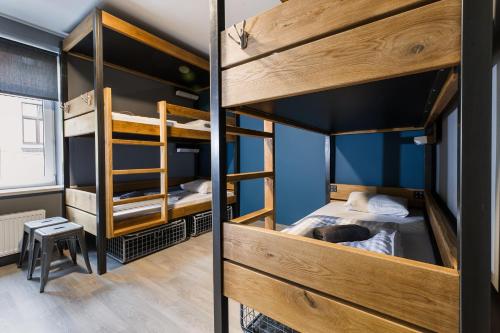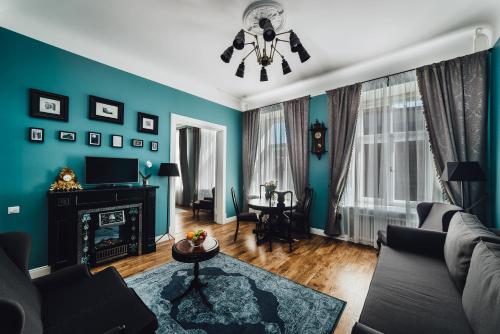Art Nouveau, Riga, Latvia
A face with wild eyes, covered in mane-like hair tied with a bow, seems to be shouting eternally.
Next to it is a long face – idiomatically apt as it looks despondent, but still handsome and perfectly formed.
Between them is a peacock, as majestic as confident, its feathers displayed in an uninterrupted fan.
None of these figures are in colour – yet their details seem so vibrant. They are each grey, carved into the top of a building with bright blue tiles, positioned between indiscernible straight lines of the roof and the curved archways in the centre.
This is Riga’s Art Nouveau, the art and architecture movement that swept through the capital of Latvia at the beginning of the 1900s and still defines the style of the city today.
Art Nouveau began a couple of decades before it hit Riga, further west in countries like France and Belgium. One of the earliest examples was the work of architect Victor Horta in Brussels, which I’ve written about previously.
What made Art Nouveau so exciting at the time (and still stirs emotions today) is that it was a dramatic shift away from mundane architecture that focused on practical and conventional shapes.
Art Nouveau brought more colour and fluidity to its design. Curves, rather than rectangles. Brightness, rather than beige. Expressive humans and animals, rather than cubes and columns.
At its heart, Art Nouveau was trying to combine fine arts like drawing and sculpture with applied arts like architecture and furniture. Why couldn’t the emotion that you see in a painting also be reflected in a building?
To this end, it’s not just the shape of the buildings that changed under this new movement. As well as curves and unusual angles, there were organic elements inspired by plants and animals, and there were the figurines and masks that turn a facade into a face.
Art Nouveau in Riga
Art Nouveau arrived in Riga at the very end of the 19th century but became a real force in the city from about 1901.
The design movement was sweeping across Europe at exactly the same time that Riga was going through an economic boom, as industrialisation led much of the Latvian population to move into the city.
Many of these middle-class Latvians were able to buy land just outside the main city walls and, coincidentally, the government relaxed the rules about building houses with stone rather than wood here.
With all of these things combined, hundreds of new buildings were constructed in the new Art Nouveau style in and around the centre of Riga. Today, most of them remain, and spending some time seeing the Art Nouveau buildings in Riga is a great way to explore the city.
Riga and its Art Nouveau facade
With hundreds of Art Nouveau buildings, you’ll undoubtedly see many of them, even if you’re not trying. But as one of the best things to do in Riga, I recommend you do take more than just a casual interest.
Because some of the most significant Art Nouveau buildings in Riga are in streets you might not otherwise walk down, it’s worth doing a little bit of investigation if you want to see the best ones.
I’ve put together this map below that shows a large number of important Art Nouveau buildings in Riga. You can see from the map that there are some in the very centre of the historic part of the city next to the river. However, most are in the nearby areas on the other side of the parks.
If you would just like to go for a wander and get a sense of the Art Nouveau of Riga, you can use the map to visit some of the areas where there’s a high concentration of buildings.
But, if you would like to see some specific examples of the best of Riga’s Art Nouveau, I have marked some particular suggestions in purple on the map.
Of course, the best way to see the highlights and learn all about the architecture is with a guide, and I would recommend this Art Nouveau tour of Riga (or, if you want to combine it with other parts of the city, then you might prefer this tour).
But, if you prefer to wander by yourself and just have a look at the facades, I would also like to share some recommendations for the best way to see the Art Nouveau buildings in Riga.
Rupniecibas and Vilandes Street
I would suggest starting your Riga Art Nouveau tour at the two parallel streets, Rupniecibas and Vilandes.
This is a quiet part of Riga and, without too much traffic or other constructions, you’ll get a good view of the whole buildings on these streets.
They don’t have the best examples – but they have some of the oldest, so it’s a good way to see the evolution of the style here in Riga.
Have a look at 11 Vilandes Street, which was built as early as 1899. The nearby number 10 has been restored, so you can imagine how these avenues would have look a century or so ago.
Alberta St
From there, make your way a few blocks to Alberta Street which is, in many ways, the heart of Art Nouveau in Riga.
The street is not very long and almost every building is in the Art Nouveau style. Each has its own characteristics and it’s the perfect spot to see some of the best buildings all in a very small space.
This also where I should introduce you to Mikhail Eisenstein, who was the designer of most of what you’ll see here.
He was actually an engineer but became more of an architect when it came to these buildings. And his focus shifted from the structural (which was pretty standard) to the exterior decorations (which is where he excelled).
Compared to what had come before, his style involved more human faces, more emotion, more mythical elements. The evolution that he created was a big influence on other architects in Latvia.
On Alberta Street, you’ll also find the Riga Art Nouveau Museum here, which is a good way to get a look inside one of the buildings to see how they were originally decorated with Art Nouveau furniture that captured the ideals of the movement.
10a & 10b Elizabetes Street
Just around the corner, you’ll find the neighbouring properties of 10a and 10b Elizabetes Street. These are also the work of Mikhail Eisenstein and are probably one of the most iconic sights of Riga.
Look up towards the top and you’ll see the incredible detail in the faces, the sun, the peacock, and all the other figures and patterns, contrasted against the rich blue tiles.
On the opposite side of the street is another of his designs, 33 Elizabetes St, which shows the range of his styles.
Commercial centre
From Elizabetes Street, I would recommend continuing into the commercial centre of Riga, where you’ll find the main shopping district and quite a few hotels and office buildings.
There are lots of examples of Art Nouveau here and you won’t have any trouble finding some interesting examples. Although there aren’t any that are particularly more famous than the others, I would point out a few buildings to check out:
* 5 Baznicas Street
* 35 Lacplesa Street
* 28 Blaumana
This is the district where only wooden buildings had been allowed previously – the logic had been they could easily be burnt down if invaders attacked, so there would be nowhere for them to hide close to the city centre.
So when authorities allowed masonry to be used, around the same time as the economic boom and the Art Nouveau movement arriving, there was a huge amount of development.
Not everything survived the Soviet period and you’ll notice there are still quite a few buildings in disrepair and need of a little love.
Historic centre
And, finally, cross the park and head into the historic centre to find the examples of Art Nouveau right here in the middle of Riga. This district is a mix of styles from across the centuries, from the Medieval public buildings, to the Neoclassical period, and even up to some modern constructions.
The Art Nouveau buildings are scattered throughout it all and are a little harder to spot, unless you know what you’re looking for. The easiest thing to do is look for faces, curvy lines, and anything a bit organic and colourful.
In particular, you might want to look for these highlights of Art Nouveau in the historic centre:
* 7 Audeju Street (which is said to be the oldest Art Nouveau in Riga)
* 23 Kaleju Street
* 25 Jauniela Street
* 10/12 Skunu Street
* 2 Smilsu Street
* 8 Smilsu Street
Of course, there are lots of other things to see and do in the historic centre of Riga, so I’m sure you’ll end up here anyway.
Art Nouveau tours in Riga
While it’s quite easy to walk through the streets of Riga and spot a lot of Art Nouveau buildings, you certainly won’t appreciate them if you’re just on your own. I would highly recommend using a guide or taking a tour so you don’t miss out on all the important details and background information.
There are a few good tours here that I would recommend:
If you are in a group, it may be cheaper (and easier) to use this private Art Nouveau tour.
Riga as a World Heritage Site
It’s worth noting that the Historic Centre of Riga has been designated as a World Heritage Site because of its architecture. Of course, a large part of that is the Art Nouveau buildings, but it’s not the only important style here.
Riga was an important part of the Hanseatic League and was a wealthy trading centre in the Baltics during the Middle Ages. The Medieval city centre that was built here between the 13th and 15th centuries is also significant and is part of the World Heritage Site.
And, as the economy boomed in Riga again in the 19th century, there were imposing wooden buildings built in the Neoclassical style in the decades before Art Nouveau took over as the fashion. Look out for some of them as well, as you wander around and discover the different layers of this beautiful city.
THE BEST ACCOMMODATION IN RIGA
You’ll be able to find some hotels in gorgeous Art Nouveau buildings and there are lots of affordable options in Riga’s historic centre.
BACKPACKER

For a clean and fun hostel, Wicked Weasel has a great location and vibe.
BUDGET
If you’re after great value in the historic centre, I would recommend Hotel Gutenbergs.
BOUTIQUE

For a beautiful art hotel, I suggest Sherlock Art Hotel, where each room has its own design.
LUXURY
And when it comes to luxury, I think the nicest hotel in the city is the Grand Hotel Kempinski Riga.
Seeing the emotion that you see in a painting in the building makes perfect sense! The neighbourhoods are so beautiful, I wish that buildings were still developed like this!